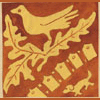
The Collections:
• Parker-Hore

|
TileWeb: Paving-tile Watercolours Online |
The Collections: |
| The Parker-Hore Archive Collection of Watercolours of Paving-tiles | ||
| held in Worcester and in the Ashmolean Museum, Oxford |
|
|
Evaluation of the project |
|
||
|
The extent to which the project has achieved its aims can be addressed under the broad headings set out as follows: Community benefits to host museum: Worcester Worcester City Council's mission includes moving towards museums being centres of contemporary thinking, this was exemplified by their Millennium exhibition `Plotting the Past Planning the Future', which traced Worcester's history from its earliest origins and it's plans for the future. Other activities are formulated as agents of social change, with increased social inclusion being a top priority. This vision put education at the centre of the museum service's work, and this emphasis is reflected in mission statements, strategies and forward plan. Such an open approach needs to inspire people to support it, particularly in a small museum which knows its community and is known by it. In this context the forging of a close link with an outside university museum such as the Ashmolean is seen as benefiting the community by adding a wider perspective. Mutual interest in the TileWeb project has stimulated a close engagement between officers of both institutions, yielding a more immediate and tangible experience than could be achieved by long range communication. Also as a result of the link forty-five members of Worcestershire Archaeological and Historical Society visited the Ashmolean in July 2001 to see the Parker-Hore Collection of watercolours held there. The party also visited the Ashmolean's collection of porcelain from the Worcester industry and the museum's gallery of classical casts. Community benefits to the seconding museum: Ashmolean Museum, Oxford
To compare the Parker-Hore decorated medieval paving-tiles corpus with surviving evidence in the field - confirming where the tiles are now and their state of preservation. To record any medieval tile designs which are not recorded in the Parker-Hore collection. To seek to establish a method of field research which can be duplicated by researchers in other counties. To extend existing knowledge by looking at the method of manufacture of the tiles, their decoration and iconography to seek to identify:-
b) local themes and motifs shown by the iconography c) local patronage TileWeb, a digital resource has enormous potential to be developed for a variety of audiences - both for schools, lifelong learners and for the cyberspace community.
|
||||
| Assembly | Framework | |||
| TileWeb Home Page | ||
|
© Copyright of this digital resource will be held jointly by last updated: jcm/7-jun-2004 |
 |
 |